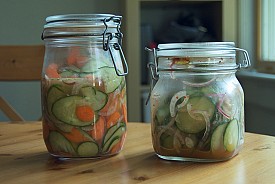Cold Pantries for Green Kitchens
 Before the advent of the refrigerator, we ate all sorts of foods that needed to be kept cool, including dairy products, meats, and fresh produce. The solution used in some homes was an icebox, containing blocks of ice to create a cold storage area for fresh foods, but the cold pantry was also a critical staple. This box or closet within the kitchen used creative ventilation and skillful design to create a cool area, allowing people to keep fragile foods while minimizing the risk of spoilage.
Before the advent of the refrigerator, we ate all sorts of foods that needed to be kept cool, including dairy products, meats, and fresh produce. The solution used in some homes was an icebox, containing blocks of ice to create a cold storage area for fresh foods, but the cold pantry was also a critical staple. This box or closet within the kitchen used creative ventilation and skillful design to create a cool area, allowing people to keep fragile foods while minimizing the risk of spoilage.
Thanks to the refrigerator, the cold pantry today is seen primarily as an interesting architectural artifact in many older homes, and in some cases, it is torn out to make way for kitchen remodels. But it's making a comeback, and you might want to think again about the cold pantry, whether you're considering ripping one out, or you're planning out a kitchen remodel and deciding what you need and where you want it to go.
Why consider a cold pantry? Cold pantries offer a lot of great advantages that make them well worth including in the modern kitchen. Here are 4 of the best:
- Preserving. They're great for fermenting foods, storing canned foods, and similar home food preservation activities. You need a cool dry place to store many of these items, and cold pantries are absolutely ideal for this purpose. Additionally, you'll free up cabinet and counter space you might be using for food processing if you install a cold pantry.
- Energy savings. With a cold pantry, you can get by with a smaller size refrigerator, which allows you to take a look at energy-efficient options. You might even ditch the fridge altogether, a choice made by some people who install cold pantries. This can be a great option for tiny houses and small kitchen spaces where there isn't a great deal of room.
- Storage of certain food items. Cold pantries are fantastic for those items you shouldn't really store in the fridge that tend to take up valuable cupboard space, such as potatoes, onions, and apples. If your cold pantry is well built, these items can keep for weeks or months, just as they did in the old days when people relied on cold pantries to help them keep their harvest over the winter. You can also store pastries, breads, pies, and the like for several days.
- Convenience when you have no electricity. If you experience power outages, rolling blackouts, or an unreliable power supply, a cold pantry is a must. While many of us in the United States don't have these problems, there are still parts of the US without reliable electric service, and cold pantries are a way of life in those regions. Around the world, cold pantries and similar methods of cold storage like root cellars are critical.
So what makes a cold pantry a cold pantry? These cupboards or closets are built with ventilation that draws cold air through the space, keeping it cool and dry. Classically, a few metal grates are fitted into the back of the cold pantry to draw up cold air from below the house, pulling it through the cold pantry and venting it above to the outside world. The shelves of the pantry are slatted, to encourage full ventilation.
Are you interested in installing a traditional cold pantry in your own home? Find a reliable carpenter to get the job done.
Katie Marks writes for Networx.com.
Updated January 22, 2018.
Looking for a Pro? Call us (866) 441-6648

Remodeling Average Costs
Remodeling Contractors Experiences

Yard Cleanup And Lawn Care Service With A Great Work Ethic

The Right Landscaper Can Change A Yard From Terrible To Terrific



